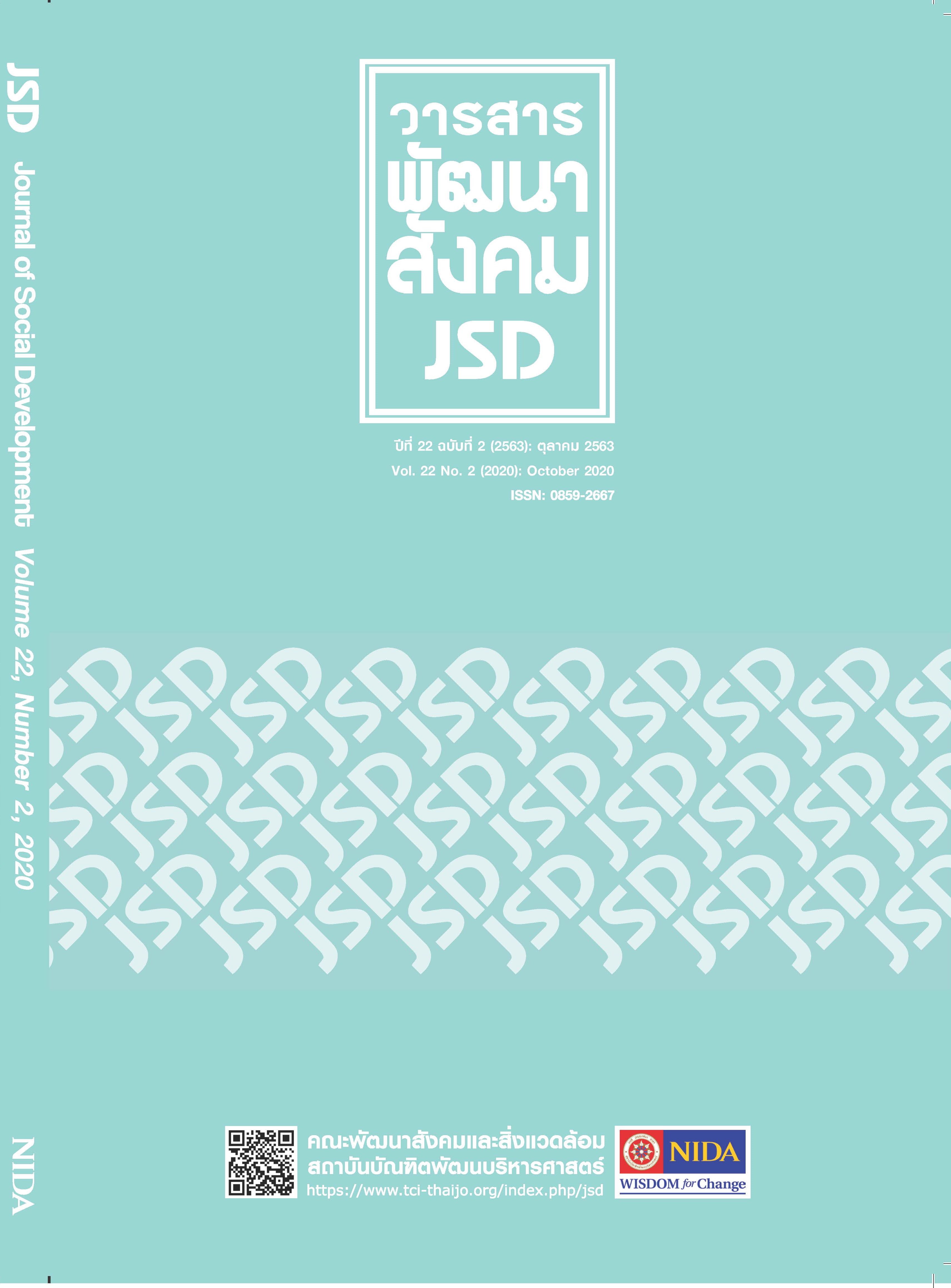Factors that Determine Access to Education among Migrant Children
Main Article Content
Abstract
This paper aims to study factors that determine access to education among migrant children aged 0-14 years old in families of migrant workers. This quantitative research is based on a structured survey data collected from 402 migrant families with a total of 803 children aged 0-14 years old. This paper is a part of a research project titled “Migrant Children Population: Contexts of Parenting, Access to Health Services and Education in Special Economic Zones (SEZ) Mae Sot, Tak Province”. Studying the access to education among migrant children shows key factors which have positive impact include being registered at birth, families planning to allow the children to live in Mae Sot District or Thailand after they turn 15 years old, awareness among the main caretakers regarding rights to education and the purchase of migrant children health insurance cards, and the main caretakers’Thai language proficiency.
Article Details
How to Cite
Apipormchaisakul, K. ., & Chamchan, C. . (2020). Factors that Determine Access to Education among Migrant Children. Journal of Social Development and Management Strategy, 22(2), 73–90. retrieved from https://so04.tci-thaijo.org/index.php/jsd/article/view/246237
Section
บทความวิจัย Research Article
References
Chamchan, C. & Apipornchaisakul, K. (2016). “Health Security for Cross-border Migrants
in Thailand: Where have we been?”. In Sureeporn Punpuing, et, al. (editors). IPSR 2016 Annual Conference Proceeding: Thailand in the Era of Transnational Migration. Publication/ Institute for Population and Social Research, Mahidol University No. 455.
Chamchan, C., Apipornchaisakul, K. & Thianlai, K. (2017). A Baseline Survey of “Empowering
Civil Society Organizations for the Protection of Migrant Children (ECPMC)” Project, Publication / Institute for Population and Social Research, Mahidol University; no. 469
Chamratrithirong, A., Punpuing, S., Boonchalaksi, W., Holumyong, C., Chamchan, C.,
Apipornchaisakul, K., Youngpanichchakul. (2014). The Impact evaluation Survey 2014 of the Prevention of HIV/AIDS among Migrant Workers in Thailand Project (PHAMIT-2). Supported by The Global Funds to Fight AIDS, Tuberculosis, and Malaria (GFATM): The Global Fund / Program on AIDS (GPA) and Raks Thai Foundation. Published by Raks Thai Foundation.
Office of Foreign Workers Administration. (2017). Statistics of migrants (Myanma, Lao and Cambosia) June 2017 (in Thai). Retrieved February 1,2018, from http://wp.doe.go.th /wp/
Office of the National Economic and Social Development Board. (2013). Population Projections
for Thailand 2010-2040 (in Thai). Bangkok: Office of the National Economic and Social Development Board.
Punpuing, S., Kusakabe, K., Holumyong, C., Chamchan, C., Darawuttimaprakorn, N. (2014).
Migrant Children’s Education in thailand. Policy Brife. Institute for Population and Social Research, Mahidol University.
Save the Children (2014). “Pathway to better future: A review of education for migrant
childreninThailand”RetrievedJune15,2018 form https://thailand.savethechildren. net/sites/thailand.savethechildren.net/files/library/Migrant%20education%20annual%20report_full_resized.pdf
Vapattanawong, P., Chamratrithirong, A., Punpuing, S., Rhucharoenpornpanich, O., &
Apipornchaisakul, K. (2016). Size and distribution of cross-border population from Myanmar, Cambodia and Lao PDR in Thailand 2015: Estimation from multiple sources (in Thai). Thai Population Journal, 5-21.
in Thailand: Where have we been?”. In Sureeporn Punpuing, et, al. (editors). IPSR 2016 Annual Conference Proceeding: Thailand in the Era of Transnational Migration. Publication/ Institute for Population and Social Research, Mahidol University No. 455.
Chamchan, C., Apipornchaisakul, K. & Thianlai, K. (2017). A Baseline Survey of “Empowering
Civil Society Organizations for the Protection of Migrant Children (ECPMC)” Project, Publication / Institute for Population and Social Research, Mahidol University; no. 469
Chamratrithirong, A., Punpuing, S., Boonchalaksi, W., Holumyong, C., Chamchan, C.,
Apipornchaisakul, K., Youngpanichchakul. (2014). The Impact evaluation Survey 2014 of the Prevention of HIV/AIDS among Migrant Workers in Thailand Project (PHAMIT-2). Supported by The Global Funds to Fight AIDS, Tuberculosis, and Malaria (GFATM): The Global Fund / Program on AIDS (GPA) and Raks Thai Foundation. Published by Raks Thai Foundation.
Office of Foreign Workers Administration. (2017). Statistics of migrants (Myanma, Lao and Cambosia) June 2017 (in Thai). Retrieved February 1,2018, from http://wp.doe.go.th /wp/
Office of the National Economic and Social Development Board. (2013). Population Projections
for Thailand 2010-2040 (in Thai). Bangkok: Office of the National Economic and Social Development Board.
Punpuing, S., Kusakabe, K., Holumyong, C., Chamchan, C., Darawuttimaprakorn, N. (2014).
Migrant Children’s Education in thailand. Policy Brife. Institute for Population and Social Research, Mahidol University.
Save the Children (2014). “Pathway to better future: A review of education for migrant
childreninThailand”RetrievedJune15,2018 form https://thailand.savethechildren. net/sites/thailand.savethechildren.net/files/library/Migrant%20education%20annual%20report_full_resized.pdf
Vapattanawong, P., Chamratrithirong, A., Punpuing, S., Rhucharoenpornpanich, O., &
Apipornchaisakul, K. (2016). Size and distribution of cross-border population from Myanmar, Cambodia and Lao PDR in Thailand 2015: Estimation from multiple sources (in Thai). Thai Population Journal, 5-21.


